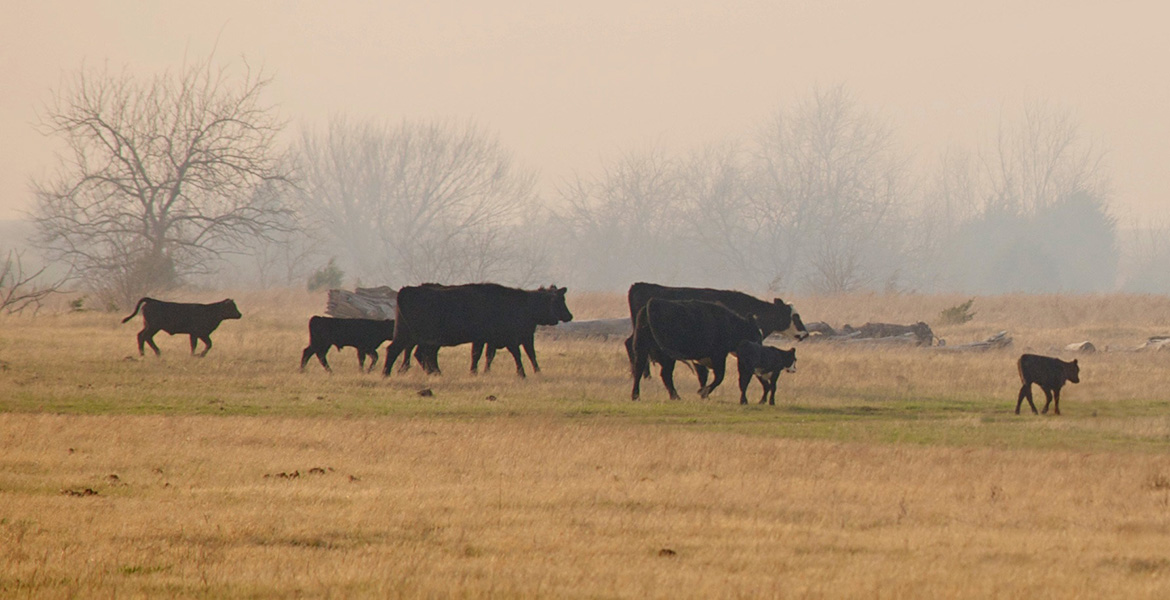
Be aware of livestock trauma after a wildfire
Thursday, April 23, 2020
Adrenaline-fueled panic and confusion may still be affecting livestock even after the flames of a recent wildfire have passed, meaning producers need to use caution when working with the animals.
“Fear is a powerful emotion in both humans and livestock,” said Kris Hiney, Oklahoma State University Extension animal scientist. “Horses tend to be more likely to return to the familiarity of their home environment, despite the fact it may be unsafe. That is why it is recommended horse managers shut barn doors or gates to prevent animals from running back to their home if they were turned out for safety reasons.”
Furthermore, horses and cattle are large creatures compared to humans and their survival instincts tend to be very sensitive. Traumatic events often leave animals in a heightened state of awareness beyond the time frame of the actual incident. As a result, normal handling techniques may be ineffective with livestock who are still traumatized from a recent wildfire.
“This can be especially true if the wildfires have passed but are still burning within the sensory range of the animals,” Hiney said. “If you’re not an experienced livestock handler, it would not be recommended to handle the animals during highly stressful events.”
Livestock reactions can range from nervousness to panic to aggressive attempts to escape anyone and anything.
Upon returning to the farm or ranch, livestock producers need to quickly locate their animals and ensure they have access to clean water and high-quality forage with a protein and mineral supplement.
“Livestock that do not have adequate nutrition and water can deteriorate rapidly in terms of their physical condition,” said Dr. Barry Whitworth, veterinarian and OSU Extension food animal quality and health specialist. “Also, check surviving livestock for signs of injury.”
Health issues such as burned eyes, burned areas of their skin, lung inflammation and edema – swelling caused by fluid buildup in the body’s tissues – from smoke inhalation are common after livestock experience a wildfire.
Whitworth said smoke inhalation may take four to six weeks to heal. Burns on feet may not show clinical signs for three weeks. Signs could be severe such as sloughing of the hooves, which would require euthanasia of the animal. Cows with burned teats and udder likely will need to be culled.
OSU Extension livestock specialists recommend bulls have a breeding soundness examination to ensure the sheath and scrotum are not damaged. Bulls need to be able to produce viable semen.
“Minor skin burns may be treated with topical and injectable antibiotics, though cattle with major skin burns likely will need to be euthanized,” Whitworth said. “I recommend cattle producers talk with their veterinarians who can provide knowledgeable assistance in making these tough decisions.”
Panicked livestock often are injured or killed by running into fences and barriers while fleeing a wildfire.
“Remember the old adage: check your livestock for injuries from fences and check your fences for damage from fleeing livestock,” Whitworth said. “It is important to have surviving animals checked by a veterinarian as soon as possible following a wildfire.”
A visit from the veterinarian also will give the producer valuable input in working up a post-wildfire checklist. Given that it can take time for symptoms to appear, livestock will need to be monitored for several weeks after a wildfire.
Agricultural producers can pick up more useful tips by watching online OSU Extension videos Wildfire Recovery, NW Oklahoma Wildfire Recovery and Preparation for Wildfire in Oklahoma.
OSU Extension is one of two state agencies administered by the university’s Division of Agricultural Sciences and Natural Resources and is a key part of OSU’s state and federally mandated teaching, research and Extension land-grant mission. Click here to find the nearest OSU Extension county office.
MEDIA CONTACT: Donald Stotts | Agricultural Communications Services | 405-744-4079 | donald.stotts@okstate.edu
